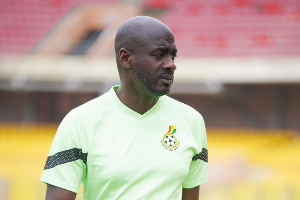One in four people worldwide would have a stroke in their lifetime, according to the world health organization.
But the extent of the damage to the brain determines what kind of care patients can get to quicken rehabilitation and recovery.
But have you thought about how much work goes into providing care for the worst affected patients?
Inside the unit
It’s another day here at the stroke unit of the Korlebu Teaching Hospital. At least I can count eight patients on admission; some with severe forms of the condition, requiring critical care. I bet they barely know what is going on; seeing my crew pacing up and down the ward with their equipment.
Principal nursing officer; Monica Naa Nuah Appiah is on duty today!
She is helping some patients feed!
“Some of the patients come here unconscious, unable to talk and unable to swallow. Others cannot walk, so nurses do all the activities of daily living for the patients,” she tells me.
I am told something as basic as turning in bed is impossible in some of the worst affected patients.
“We bath the patients, change their diapers because they are unable to control urine and stool.”
Monica says, “we also treat their pressure areas because when they lay in one position for a long time, they would end up getting bedsores, so we do the regular turning of patients in bed.”
The youngest patient here is only twenty-two years.
But there are others who are older. Monica and her colleagues have to cater for them all; based on their specific needs.
Other patients
Few meters away from where I stand, two people in masks, wearing purple-like hospital scrubs are helping one patient sit up.
He looks in his mid-forties, but I would not bother to ask.
I would later find out, the two staff holding and helping him up are physiotherapists.
One of them, the principal physiotherapist, Cynthia Osei Yeboah is leading her colleagues to take this man through some light body and joint movement sessions.
This patient, unlike the others I have seen so far, is conscious; and can eat and swallow, I would imagine.
In the far end of the ward, a dark-skinned woman lay, with what the nurses here call nasogastric tube connected.
She is being aided to sit up while the nurse, wearing a pair of glasses, stirs up a mixture of what looked like soy milk to be given to the patient, from a feeding tube!
Care during covid 19
The covid 19 pandemic shattered many sectors of the economy. Many are still reeling under the impact of a virus that’s claimed over one point one million (1.1m) lives globally.
But even at the height of the covid-19 pandemic in Ghana; nurses and other health workers at the stroke unit, were here to assist patients on admission.
In fact, the unit recorded some fresh cases during the lockdown and when restrictions were imposed.
Monica says, it was tough, coming to work every day, knowing the risks, were all too pronounced.
“Despite the fact that there was covid 19, people were still coming down with stroke, we had a lot of cases here,” she tells me while ‘making faces’, beneath her mask.
“We were coming to work every day to attend to our stroke patients here, all through the pandemic. And the challenge was, we did not even know which of the patients coming in had the virus or not.”
The principal nursing officer recalls, “because we were not at the isolation center we did not have enough personal protective equipment (PPEs). We only had our mask and gloves to face the pandemic, but we are happy we have overcome it.”
Beyond the nurses
While the nurses are at it; the doctors and other medics also help through the rehabilitation process for stroke patients.
Physician specialist and one of the doctors here, Dr. David Brodie Mends wants people to guard against obesity and overweight.
“When you have what we call central obesity, that is the potbelly in men around the waist area, it tends to increase your risk for strokes,” he tells me.
“Know your weight, know your height and if you have a body mass index of either twenty-five and above, your risk of stroke is higher.”
For dietician Andrew Kpabi, controlling what we eat can go a long way to reduce the risks of getting a stroke.
He says, “some foods, when taken in excess can make your weight go up and can affect your blood pressure. Generally, people who eat outside, and are hypertensive could have a risk of getting a stroke because some ingredients like salt could be harmful to their health.”
“We recommend that people eat foods prepared at home, so we can account for the ingredients. That is a way to reduce their risk levels.”
The stroke nurse’ appeal
Monica Naa Nuah Appiah and her colleagues want Ghanaians to make changes to their lifestyles.
“We are saying join the movement, it is more of physical activity; exercise.”
She says, “we have to identify the conditions that we have. If you're diabetic, control the sugar by taking your drugs regularly.”
Monica also wants, “people who are hypertensive to take anti-hypertensives regularly.”
If you are stress and depressed, make time to REST!
Health News of Saturday, 31 October 2020
Source: 3news.com

















